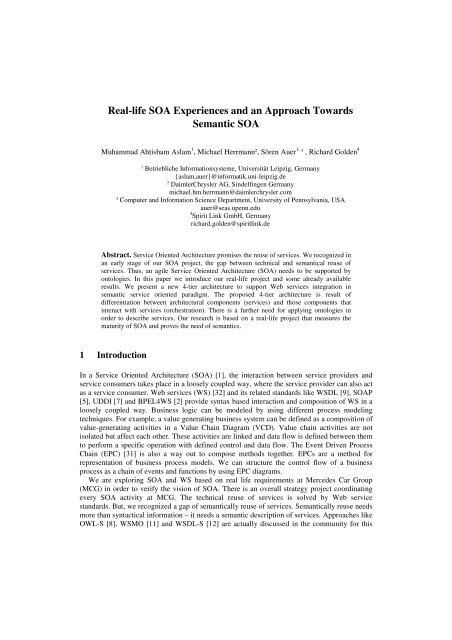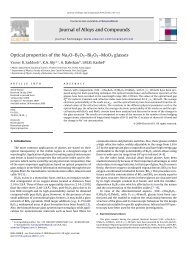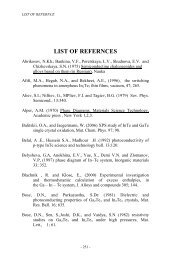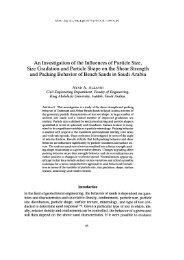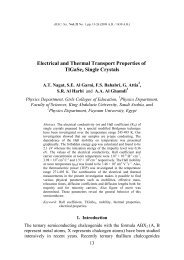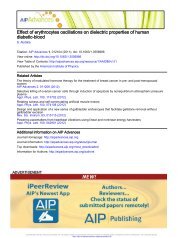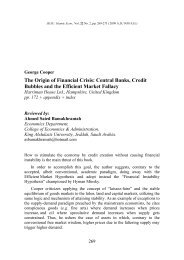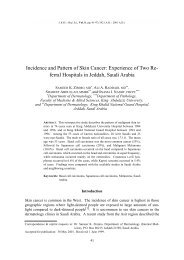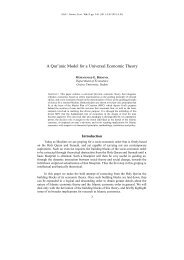Real-life SOA Experiences and an Approach Towards Semantic SOA
Real-life SOA Experiences and an Approach Towards Semantic SOA
Real-life SOA Experiences and an Approach Towards Semantic SOA
You also want an ePaper? Increase the reach of your titles
YUMPU automatically turns print PDFs into web optimized ePapers that Google loves.
<strong>Real</strong>-<strong>life</strong> <strong>SOA</strong> <strong>Experiences</strong> <strong><strong>an</strong>d</strong> <strong>an</strong> <strong>Approach</strong> <strong>Towards</strong><br />
Sem<strong>an</strong>tic <strong>SOA</strong><br />
Muhammad Ahtisham Aslam 1 , Michael Herrm<strong>an</strong>n 2 , Sören Auer 1, 3<br />
, Richard Golden 4<br />
1<br />
Betriebliche Informationsysteme, Universität Leipzig, Germ<strong>an</strong>y<br />
{aslam,auer}@informatik.uni-leipzig.de<br />
2<br />
DaimlerChrysler AG, Sindelfingen Germ<strong>an</strong>y<br />
michael.hm.herrm<strong>an</strong>n@daimlerchrysler.com<br />
3<br />
Computer <strong><strong>an</strong>d</strong> Information Science Department, University of Pennsylv<strong>an</strong>ia, USA<br />
auer@seas.upenn.edu<br />
4 Spirit Link GmbH, Germ<strong>an</strong>y<br />
richard.golden@spiritlink.de<br />
Abstract. Service Oriented Architecture promises the reuse of services. We recognized in<br />
<strong>an</strong> early stage of our <strong>SOA</strong> project, the gap between technical <strong><strong>an</strong>d</strong> sem<strong>an</strong>tical reuse of<br />
services. Thus, <strong>an</strong> agile Service Oriented Architecture (<strong>SOA</strong>) needs to be supported by<br />
ontologies. In this paper we introduce our real-<strong>life</strong> project <strong><strong>an</strong>d</strong> some already available<br />
results. We present a new 4-tier architecture to support Web services integration in<br />
sem<strong>an</strong>tic service oriented paradigm. The proposed 4-tier architecture is result of<br />
differentiation between architectural components (services) <strong><strong>an</strong>d</strong> those components that<br />
interact with services (orchestration). There is a further need for applying ontologies in<br />
order to describe services. Our research is based on a real-<strong>life</strong> project that measures the<br />
maturity of <strong>SOA</strong> <strong><strong>an</strong>d</strong> proves the need of sem<strong>an</strong>tics.<br />
1 Introduction<br />
In a Service Oriented Architecture (<strong>SOA</strong>) [1], the interaction between service providers <strong><strong>an</strong>d</strong><br />
service consumers takes place in a loosely coupled way, where the service provider c<strong>an</strong> also act<br />
as a service consumer. Web services (WS) [32] <strong><strong>an</strong>d</strong> its related st<strong><strong>an</strong>d</strong>ards like WSDL [9], <strong>SOA</strong>P<br />
[5], UDDI [7] <strong><strong>an</strong>d</strong> BPEL4WS [2] provide syntax based interaction <strong><strong>an</strong>d</strong> composition of WS in a<br />
loosely coupled way. Business logic c<strong>an</strong> be modeled by using different process modeling<br />
techniques. For example, a value generating business system c<strong>an</strong> be defined as a composition of<br />
value-generating activities in a Value Chain Diagram (VCD). Value chain activities are not<br />
isolated but affect each other. These activities are linked <strong><strong>an</strong>d</strong> data flow is defined between them<br />
to perform a specific operation with defined control <strong><strong>an</strong>d</strong> data flow. The Event Driven Process<br />
Chain (EPC) [31] is also a way out to compose methods together. EPCs are a method for<br />
representation of business process models. We c<strong>an</strong> structure the control flow of a business<br />
process as a chain of events <strong><strong>an</strong>d</strong> functions by using EPC diagrams.<br />
We are exploring <strong>SOA</strong> <strong><strong>an</strong>d</strong> WS based on real <strong>life</strong> requirements at Mercedes Car Group<br />
(MCG) in order to verify the vision of <strong>SOA</strong>. There is <strong>an</strong> overall strategy project coordinating<br />
every <strong>SOA</strong> activity at MCG. The technical reuse of services is solved by Web service<br />
st<strong><strong>an</strong>d</strong>ards. But, we recognized a gap of sem<strong>an</strong>tically reuse of services. Sem<strong>an</strong>tically reuse needs<br />
more th<strong>an</strong> syntactical information – it needs a sem<strong>an</strong>tic description of services. <strong>Approach</strong>es like<br />
OWL-S [8], WSMO [11] <strong><strong>an</strong>d</strong> WSDL-S [12] are actually discussed in the community for this
purpose. OWL-S is suite of ontologies based on the W3C st<strong><strong>an</strong>d</strong>ard OWL [13] <strong><strong>an</strong>d</strong> consists of<br />
Profile, Process Model <strong><strong>an</strong>d</strong> Grounding ontologies. Some work is done in order to map BPEL to<br />
OWL-S sem<strong>an</strong>tic Web services [14, 33]. Several research papers have investigated different<br />
approaches for discovering <strong><strong>an</strong>d</strong> locating the sem<strong>an</strong>tically matching Web services [15, 16, 17].<br />
This paper is org<strong>an</strong>ized as follows; the overall strategy project at MCG <strong><strong>an</strong>d</strong> some of its<br />
results are described in section 2. Sem<strong>an</strong>tic enh<strong>an</strong>cements in the <strong>SOA</strong> are discussed in section<br />
3. Section 4 describes the 4-tier architecture for Web services integration in sem<strong>an</strong>tic service<br />
oriented paradigm. Related work is discussed in section 5 <strong><strong>an</strong>d</strong> section 6 concludes <strong><strong>an</strong>d</strong> describes<br />
future directions for our work.<br />
2 <strong>SOA</strong> activity at Mercedes Car Group (MCG)<br />
The MCG M<strong>an</strong>agement decided to explore the vision of <strong>SOA</strong> <strong><strong>an</strong>d</strong> created a strategic project at<br />
MCG. We are going to name the work packages (WP), list the topics <strong><strong>an</strong>d</strong> describe some already<br />
available results of the project. We are also going to explore the need of sem<strong>an</strong>tics in order to<br />
reuse services. This overall strategy project is coordinating every <strong>SOA</strong> activity at the MCG. It<br />
coordinates but also supplements each single project (e.g. with a security concept in order to<br />
implement a common secure machine-to-machine communication). The project is cut into five<br />
working packages. The deliverable of WP1 is a well defined Reference Architecture; the<br />
deliverable of WP2 is a Development L<strong><strong>an</strong>d</strong>scape for projects; WP3 deliverables the hosting of<br />
<strong>SOA</strong>-projects; WP4 delivers the m<strong>an</strong>aging of Org<strong>an</strong>ization, Govern<strong>an</strong>ce <strong><strong>an</strong>d</strong> Guid<strong>an</strong>ce; <strong><strong>an</strong>d</strong><br />
WP5 delivers the modeling of business processes <strong><strong>an</strong>d</strong> adapting the Service-Oriented Modeling<br />
<strong><strong>an</strong>d</strong> Architecture (SOMA) [3]. A final result of the project is the positioning the strategic<br />
products in our enterprise. We have identified the following topics (r<strong><strong>an</strong>d</strong>om order) to verify the<br />
vision of <strong>SOA</strong>:<br />
• Modeling processes in EPCs<br />
• Tool based tr<strong>an</strong>sformation from EPC to BPEL<br />
• Deploying the process in the process engine<br />
• Orchestrate services (exemplary)<br />
• Communication of the services over a unified infrastructure<br />
• Web services<br />
• Implementing (at least) one registry<br />
• Closer look at the top down approach<br />
• Security<br />
• Service Life Cycle M<strong>an</strong>agement<br />
• Operational aspects like availability of each IT system <strong><strong>an</strong>d</strong> monitoring the infrastructure<br />
• Explore the Enterprise Service Bus (ESB) [4]<br />
We are going to describe requirements of the topic Security in this paragraph <strong><strong>an</strong>d</strong> already<br />
available results of the topics Web services <strong><strong>an</strong>d</strong> Enterprise Service Bus in the following<br />
paragraphs. There is a deeper look at security in sense of h<strong><strong>an</strong>d</strong>ling our four different parts of<br />
data classification specified in our policies: public, internal, confidential <strong><strong>an</strong>d</strong> secret. We expect<br />
experiences in supplier based security <strong><strong>an</strong>d</strong> Web services security in order to solve unlimited<br />
communication between different classified services. We focus on Host to Java communication<br />
<strong><strong>an</strong>d</strong> services that are hosted by a Host-System. Security aspects like authentication,
authorization, logging <strong><strong>an</strong>d</strong> classification of the data are well known challenges, which should be<br />
solved.<br />
We had a closer look at Web service technology in past. Guidelines like using at least basic<br />
profile of WS-I st<strong><strong>an</strong>d</strong>ards, not publishing overloaded methods in Web services interfaces <strong><strong>an</strong>d</strong><br />
creating WSDL first, then implement the service (contract first) have been established in our<br />
Enterprise. But, guidelines in such a dynamic technology have to be monitored const<strong>an</strong>tly in<br />
order to adopt them.<br />
We are dividing the topic ESB into concept of ESB <strong><strong>an</strong>d</strong> products of ESB. In small comp<strong>an</strong>ies<br />
their concept may be solved by one product. In lager comp<strong>an</strong>ies one product is not powerful<br />
enough to solve the requirement of integrating different platforms. Normally, larger comp<strong>an</strong>ies<br />
have COBOL applications hosted on Systems like OS/390 or z/OS (legacy) <strong><strong>an</strong>d</strong> on the other<br />
h<strong><strong>an</strong>d</strong> J2EE application hosted in <strong>an</strong> Application Server. Thus, there is a need of a unified<br />
communication of those platforms, which c<strong>an</strong> be solved by the concept of <strong>an</strong> ESB (fig. 1).<br />
Fig. 1 enterprise-wide integration concept<br />
The left side of figure 1 shows the traditional communication concepts to support the<br />
integration of legacy systems by binary messages. The right side of figure 1 shows the Web<br />
service based communication to integrate non-legacy systems like SAP, J2EE <strong><strong>an</strong>d</strong> .NET by<br />
XML messages. The two are connected (via adapter) to provide <strong>an</strong> enterprise-wide<br />
communication that combines features to support Web service technologies <strong><strong>an</strong>d</strong> the integration<br />
for messaging applications. The adapter integrates both massaging systems by mapping <strong><strong>an</strong>d</strong><br />
tr<strong>an</strong>sformation. The left side of fig. 1 is shadowed, because we expect more inst<strong>an</strong>ces of<br />
supporting WS technology in future. More th<strong>an</strong> one inst<strong>an</strong>ce of the left side has to be integrated<br />
by <strong>an</strong> inst<strong>an</strong>ce of the right side (broker).<br />
In our ongoing strategy project at MCG we are going to verify the vision of <strong>SOA</strong> with<br />
available products of our suppliers. We recognized in <strong>an</strong> early stage of the project, the gap<br />
between technical (realized by WS st<strong><strong>an</strong>d</strong>ards) <strong><strong>an</strong>d</strong> sem<strong>an</strong>tical reuse of services. Sem<strong>an</strong>tically<br />
reuse needs more th<strong>an</strong> technical information – it needs a sem<strong>an</strong>tic description of the services.<br />
The Chapters 3 <strong><strong>an</strong>d</strong> 4 outlined our ongoing lab based work in order to describe services<br />
sem<strong>an</strong>tically.
3 Sem<strong>an</strong>tics in Service Oriented Architecture<br />
We are realizing a lab based applying of sem<strong>an</strong>tics into a business process, which is carefully<br />
selected from the project described in Chapter 2. We are going to outline the carefully selected<br />
process <strong><strong>an</strong>d</strong> the sem<strong>an</strong>tic approach in the following paragraphs. This EPC is the basis of our<br />
work in the lab: The “pl<strong>an</strong>ning <strong><strong>an</strong>d</strong> execution” process is being executed each day in the<br />
morning in order to pl<strong>an</strong> the assembly of the engines. The orders of assembling itself,<br />
assembling jobs <strong><strong>an</strong>d</strong> best batch sizes are going to be assigned. Therefore we need information<br />
about the availability of components, the need of engines <strong><strong>an</strong>d</strong> assembly restrictions like number<br />
of employees, capacity <strong><strong>an</strong>d</strong> availability of the equipment. The process flow is coordinating<br />
production, assembly, pl<strong>an</strong>er of assembly <strong><strong>an</strong>d</strong> scheduler/controller. The flow detects release<br />
order, determinates the need of engines, passes the plausibility check, calculates targets, passes<br />
restrictions check, creates production order, proves production order, <strong><strong>an</strong>d</strong> fixes the amount <strong><strong>an</strong>d</strong><br />
the order of production. The following paragraphs describe the basis of our approach by adding<br />
sem<strong>an</strong>tics to EPC “pl<strong>an</strong>ning <strong><strong>an</strong>d</strong> execution”.<br />
The goal is to model IOPE (inputs, outputs, preconditions, effects) [8] of each process step at<br />
the EPC “pl<strong>an</strong>ning <strong><strong>an</strong>d</strong> execution”, in the area of “power train”, sem<strong>an</strong>tically. Additionally we<br />
are defining <strong>an</strong> automotive ontology based on the general concept of automobiles. We are<br />
adding specific constraints, inst<strong>an</strong>ces of cars like <strong>an</strong> SLK (which is a Roadster) <strong><strong>an</strong>d</strong> the ITsystems<br />
needed to support the well selected process “pl<strong>an</strong>ning <strong><strong>an</strong>d</strong> execution” described above.<br />
We are considering the maturity of OWL in regards to modeling the requirements of specific<br />
departments within MCG. We expect to gain signific<strong>an</strong>t experiences in modeling real-<strong>life</strong><br />
requirements, in proving the maturity of OWL <strong><strong>an</strong>d</strong> in defining the restrictions of reusable<br />
enterprise ontologies. But, modeling IOPE’s based on ontologies is not enough to realize a<br />
sem<strong>an</strong>tic <strong>SOA</strong> the lack of common underst<strong><strong>an</strong>d</strong>ing of services between the particip<strong>an</strong>ts of a <strong>SOA</strong><br />
<strong><strong>an</strong>d</strong> adding sem<strong>an</strong>tics in the <strong>SOA</strong> aims at providing shared me<strong>an</strong>ing of business services within<br />
<strong>an</strong> org<strong>an</strong>ization <strong><strong>an</strong>d</strong> probably across the org<strong>an</strong>izational boundary. Traditional <strong>SOA</strong> has three<br />
particip<strong>an</strong>ts- Service Provider, Service Requester <strong><strong>an</strong>d</strong> Service Registry <strong><strong>an</strong>d</strong> sem<strong>an</strong>tic<br />
enh<strong>an</strong>cements improve the role of the particip<strong>an</strong>ts of <strong>SOA</strong> as:<br />
• Sem<strong>an</strong>tic Web Service Provider<br />
• Sem<strong>an</strong>tic Web Service Requester<br />
• Sem<strong>an</strong>tic Web Service Registry<br />
Sem<strong>an</strong>tic Web service provider c<strong>an</strong> develop <strong><strong>an</strong>d</strong> advertise a Web service that provides its<br />
machine underst<strong><strong>an</strong>d</strong>able me<strong>an</strong>ing. Using a sem<strong>an</strong>tic Web services l<strong>an</strong>guage c<strong>an</strong> provide such<br />
machine underst<strong><strong>an</strong>d</strong>able description of Web services. Three major c<strong><strong>an</strong>d</strong>idates for sem<strong>an</strong>tic Web<br />
services (SWS) st<strong><strong>an</strong>d</strong>ards are OWL-S, WSDL-S <strong><strong>an</strong>d</strong> WSMO (fig. 2). The sem<strong>an</strong>tic Web service<br />
provider <strong>an</strong>notates services with domain ontologies to provide shared me<strong>an</strong>ing of their Web<br />
service functionality by using <strong>an</strong>y of these l<strong>an</strong>guages. Publishing SWS suppose that the service<br />
registry supports such SWS advertisements ([15]).<br />
The requester of a WS is interested in finding a service that fulfills his functional<br />
requirements. A requester c<strong>an</strong> find a service m<strong>an</strong>ually or c<strong>an</strong> define a Web service request<br />
<strong>an</strong>notated with domain ontologies to provide request sem<strong>an</strong>tics (OWL-S Profile ontology).<br />
Such sem<strong>an</strong>tic requests c<strong>an</strong> be used by computer agents to dynamically discover required<br />
services (e.g. [16] describes <strong>an</strong> approach to <strong>an</strong>notate <strong><strong>an</strong>d</strong> discover web services by matching<br />
sem<strong>an</strong>tics). The work discussed in [17] describes such <strong>an</strong> approach to automatically locate a<br />
Web service. Current UDDI structure supports only key word based searching of required
services. Such keyword based searching is inefficient <strong><strong>an</strong>d</strong> not precise because it finds those<br />
services also which are not performing the required functionality. Sem<strong>an</strong>tic enh<strong>an</strong>cements in<br />
service registries dem<strong><strong>an</strong>d</strong> more efficient mech<strong>an</strong>ism to discover the required services on the<br />
basis of matching sem<strong>an</strong>tics. Locating the required services efficiently (sem<strong>an</strong>tically) is<br />
required by the sem<strong>an</strong>tic enh<strong>an</strong>cements in the service registries. A good work has been done<br />
<strong><strong>an</strong>d</strong> is continuously improving the sem<strong>an</strong>tic base discovery of Web service by improving search<br />
algorithms [18] <strong><strong>an</strong>d</strong> enh<strong>an</strong>cing the registry architecture. Chapter 4 describes a 4-tier architecture<br />
to address the integration issues raised with sem<strong>an</strong>tic enh<strong>an</strong>cements in the <strong>SOA</strong> <strong><strong>an</strong>d</strong> Web<br />
services.<br />
OWL-S<br />
WSMO<br />
WSDL-S<br />
Discover<br />
SWS<br />
SWS<br />
SWS<br />
Registery<br />
Publish<br />
SWS<br />
OWL-S<br />
WSDL<br />
Web Service<br />
Sem<strong>an</strong>tic<br />
Annotation<br />
Sem<strong>an</strong>tic<br />
Annotation<br />
WSDL-S<br />
Invoke<br />
Sem<strong>an</strong>tic<br />
Annotation<br />
Sem<strong>an</strong>tic Web<br />
Service Requester<br />
Sem<strong>an</strong>tic Web<br />
Service Provider<br />
WSMO<br />
Fig. 2 Sem<strong>an</strong>tics based Service Oriented Architecture.<br />
4 <strong>SOA</strong> <strong><strong>an</strong>d</strong> 4-Tier Integration Architecture<br />
Chapter 4 is <strong>an</strong> approach in order to bridge the gap between real <strong>life</strong> <strong>SOA</strong> (chapter 2) <strong><strong>an</strong>d</strong><br />
sem<strong>an</strong>tic Web services (chapter 3). <strong>SOA</strong> <strong><strong>an</strong>d</strong> sem<strong>an</strong>tics are considered from different<br />
communities. This section describes how 4-tier architecture helps to meet these integration<br />
issues raised with sem<strong>an</strong>tic enh<strong>an</strong>cements in the <strong>SOA</strong>.<br />
As the Web becomes more sem<strong>an</strong>tic <strong><strong>an</strong>d</strong> applications become more agile the need for <strong>an</strong><br />
additional architectural layer becomes more prevalent. This new architectural layer<br />
choreographs the business rules <strong><strong>an</strong>d</strong> orchestrates the services by using ontologies. Figure 3<br />
outlines how the choreography <strong><strong>an</strong>d</strong> orchestration layer (CO-Layer) <strong><strong>an</strong>d</strong> services layer in the<br />
“new” 4-tier architecture evolved from the business logic layer of the current 3-tier application<br />
integration architecture. This new architectural layer is not original. It is derived from the<br />
natural evolution of the business logic layer. The four layers in the proposed 4-tier integration<br />
architecture cooperate in order to provide the overall functionality. The invocation relationship
etween the four layers is strict top-down invocation relationship. That is, components in upper<br />
layers invoke components in lower layers in order to accomplish their functionality <strong><strong>an</strong>d</strong> lower<br />
layers c<strong>an</strong>not invoke components in upper layers. This avoids circular invocation dependencies<br />
<strong><strong>an</strong>d</strong> ensures that the functionality separation is followed [19].<br />
Fig. 3 4-tier sem<strong>an</strong>tic Web services integration architecture.<br />
The 4-tier sem<strong>an</strong>tic Web services integration architecture consists of the following four tiers:<br />
• Presentation Layer<br />
• Choreography <strong><strong>an</strong>d</strong> Orchestration Layer (Business Logic Layer)<br />
• Services Layer (Business Logic Layer)<br />
• Persistence Layer<br />
Presentation Layer provides interface to interact with integrated applications. Different<br />
interfaces c<strong>an</strong> be provided to meet different integration requirements. For example XML<br />
provides a cross-platform st<strong><strong>an</strong>d</strong>ard for creating interface. It enables better reuse of user interface<br />
– presentation layer – in complex integration scenarios. Also, it c<strong>an</strong> bypass some WSDL<br />
complexities when <strong>an</strong>notated with domain ontologies to provide data sem<strong>an</strong>tics. Different XML<br />
messages <strong><strong>an</strong>d</strong> input/output data creates the interface between presentation layer <strong><strong>an</strong>d</strong> business<br />
logic layer. Execution of business logic (process) is closely dependent on these messages <strong><strong>an</strong>d</strong><br />
data bridging the co-ordination between presentation layer <strong><strong>an</strong>d</strong> business logic layer (CO-Layer<br />
<strong><strong>an</strong>d</strong> services layer). The resulted integrated application (service) c<strong>an</strong> also present its interface<br />
(XML interface) for further co-operation with other services <strong><strong>an</strong>d</strong> applications. This interface<br />
c<strong>an</strong> also be <strong>an</strong>notated with ontologies. Such a sem<strong>an</strong>tic interface helps in further dynamic <strong><strong>an</strong>d</strong><br />
automated discovery, composition <strong><strong>an</strong>d</strong> invocation of these integrated services by sem<strong>an</strong>tic<br />
enabled systems. Business Logic Layer contains the components that implement the integration<br />
functionality. In traditional business application integration scenarios, business logic layer
define the control <strong><strong>an</strong>d</strong> data flow between the integrated applications <strong><strong>an</strong>d</strong> implement the business<br />
rules <strong><strong>an</strong>d</strong> business logic. Components in business logic layer interact with the preceding layer<br />
components by using some application adapter; data tr<strong>an</strong>sport protocols <strong><strong>an</strong>d</strong> or formats (fig. 3).<br />
As long as business applications development trend has ch<strong>an</strong>ged to business service<br />
development (extended with domain specific sem<strong>an</strong>tics) <strong><strong>an</strong>d</strong> the business logic layer comes in<br />
to focus, we begin to differentiate between architectural components that provide services <strong><strong>an</strong>d</strong><br />
those components that either orchestrate services (service composition on the basis of matching<br />
sem<strong>an</strong>tics <strong><strong>an</strong>d</strong> aggregation) or choreograph them (business rules <strong><strong>an</strong>d</strong> workflow). This difference<br />
between components that realize specific use-cases (services) <strong><strong>an</strong>d</strong> components that org<strong>an</strong>ize<br />
those use-cases into dynamic business rules (choreography <strong><strong>an</strong>d</strong> orchestration) is emphasized by<br />
splitting the business logic layer in two. These two layers jointly play the same role as business<br />
logic layer (i.e. event m<strong>an</strong>agement, process m<strong>an</strong>agement, data m<strong>an</strong>agement) <strong><strong>an</strong>d</strong> m<strong>an</strong>aging the<br />
control <strong><strong>an</strong>d</strong> data flow between services. When talking about integration architecture for SWS,<br />
we discuss the role of CO-Layer <strong><strong>an</strong>d</strong> services layer individually.<br />
The CO-Layer choreographs <strong><strong>an</strong>d</strong> orchestrates the services in the service layer with business<br />
rules <strong><strong>an</strong>d</strong> sem<strong>an</strong>tics. This is the agile layer of the 4-tier software architecture model. This layer<br />
is required to be dynamic - to meet the ch<strong>an</strong>ging requirements of the business enterprise. CO-<br />
Layer also needs to be adaptable as the enterprise grows through merger <strong><strong>an</strong>d</strong> acquisitions.<br />
Business logic <strong><strong>an</strong>d</strong> business rules c<strong>an</strong> be implemented here by separating them from the<br />
underlying infrastructure of the system’s operation. These rules c<strong>an</strong> be implemented in some<br />
structure l<strong>an</strong>guage. Even though CO-Layer <strong><strong>an</strong>d</strong> Services layer are emerged from business logic<br />
layer but components in these layers coordinate in such a way that these components are<br />
invoked precisely <strong><strong>an</strong>d</strong> in the right order by sending <strong><strong>an</strong>d</strong> receiving messages between CO-Layer<br />
<strong><strong>an</strong>d</strong> service layer components.<br />
The Services Layer is not new. For m<strong>an</strong>y it remains equivalent to the business logic layer <strong><strong>an</strong>d</strong><br />
contains a business rule service. The services layer is the realization of business processes in<br />
terms of discrete service definitions. This layer is inherently static as these services are tightly<br />
coupled to their implementations. However, when consistently defined in terms of IOPE with<br />
domain ontologies, services begin to reveal patterns of behaviour that c<strong>an</strong> be modelled <strong><strong>an</strong>d</strong><br />
orchestrated. As discussed above that the proposed integration architecture is a top down<br />
approach in which components in upper layer c<strong>an</strong> invoke components in lower layer therefore,<br />
business logic layer c<strong>an</strong> be interfaced with persistence layer by using some application adapters,<br />
protocols <strong><strong>an</strong>d</strong> data tr<strong>an</strong>sport formats to exch<strong>an</strong>ge messages. Splitting the business logic layer in<br />
to CO layer <strong><strong>an</strong>d</strong> service layer results in <strong>an</strong> additional interface to query for sem<strong>an</strong>tic Web<br />
services <strong><strong>an</strong>d</strong> getting its response.<br />
The reliability of the application integration architecture is intimately dependent on<br />
persistence components (Persistence Layer). In the whole integration architecture database<br />
systems are used to store <strong><strong>an</strong>d</strong> to m<strong>an</strong>age data. The data includes the messages, events, processes<br />
<strong><strong>an</strong>d</strong> configuration data. One possibility is to store all the information in some database but file<br />
systems c<strong>an</strong> also be used to store data in files as part of persistence layer. The newly emerged<br />
layer “service layer” in the integration architecture added <strong>an</strong> additional component to<br />
persistence layer (i.e. SWS registry). The CO-Layer <strong><strong>an</strong>d</strong> services layer <strong><strong>an</strong>d</strong> persistence layer coordinate<br />
by sending query for a required sem<strong>an</strong>tic Web service (sem<strong>an</strong>tic Web service request)<br />
<strong><strong>an</strong>d</strong> getting its response (sem<strong>an</strong>tic Web service response).<br />
The 4-tier sem<strong>an</strong>tic Web services integration architecture supports by integrating the<br />
sem<strong>an</strong>tically enriched Web services but it is not enough for dynamic, semi-automatic <strong><strong>an</strong>d</strong><br />
automatic <strong>an</strong>notation, advertisement, discovery, selection, composition <strong><strong>an</strong>d</strong> execution of interorg<strong>an</strong>ization<br />
business logic, making the Internet become a global common platform where
org<strong>an</strong>izations <strong><strong>an</strong>d</strong> individuals communicate among each other to carry out various commercial<br />
activities <strong><strong>an</strong>d</strong> to provide value-added services [20].<br />
5. Related Work<br />
The work discussed in [20] addresses very well different areas about the sem<strong>an</strong>tic<br />
enh<strong>an</strong>cements in Web services <strong><strong>an</strong>d</strong> dynamic discovery, invocation <strong><strong>an</strong>d</strong> composition issues. This<br />
work does not discuss about ch<strong>an</strong>ges in application integration architecture with upcoming Web<br />
services technology. This issue is well addressed in our work. An implementation architecture<br />
for business information systems has been discussed in [22]. This work describes the n-layer<br />
information system architecture <strong><strong>an</strong>d</strong> role of each layer in <strong>an</strong> integration scenario. However, how<br />
these layers are interlinked with each other is not addressed in this paper. The n-layer<br />
architecture completely ignores WS <strong><strong>an</strong>d</strong> SWS technology. The success of the industrial <strong><strong>an</strong>d</strong><br />
academic research related to the <strong>SOA</strong> <strong><strong>an</strong>d</strong> SWS depends on the success of ongoing efforts for<br />
the SWS development st<strong><strong>an</strong>d</strong>ards <strong><strong>an</strong>d</strong> how well its related issues have been addressed. Also,<br />
interoperability, collaboration <strong><strong>an</strong>d</strong> implementation of SWS related issues (as discussed above)<br />
<strong><strong>an</strong>d</strong> modeling <strong><strong>an</strong>d</strong> integration architecture is import<strong>an</strong>t in this domain.<br />
So far there have been several efforts for the st<strong><strong>an</strong>d</strong>ardization of SWS technologies (e.g.<br />
WSDL-S, OWL-S, <strong><strong>an</strong>d</strong> WSMO). The WSDL-S proposal by the LSDIS Lab has been submitted<br />
to the W3C for st<strong><strong>an</strong>d</strong>ardization. The LSDIS Lab has also presented their work on <strong>an</strong>notating<br />
<strong><strong>an</strong>d</strong> publishing the WSDL services by using the WSDL-S [23, 24]. The LSDIS project team has<br />
also presented their work for dynamic discovery [25, 26] <strong><strong>an</strong>d</strong> composition [27] of these WSDL-<br />
S services. OWL-S is under discussion on the W3C platform <strong><strong>an</strong>d</strong> is part of the DAML program<br />
for the Sem<strong>an</strong>tic Web <strong><strong>an</strong>d</strong> the SWSs. The OWL-S 1.2 has been released at the time of writing<br />
this paper <strong><strong>an</strong>d</strong> consists of Profile, Process Model <strong><strong>an</strong>d</strong> Grounding ontologies. OWL-S supports<br />
compatibility between complex messages by using XSL Tr<strong>an</strong>sformations [28]. The Web<br />
Services Modeling Ontology (WSMO) is <strong>an</strong>other c<strong><strong>an</strong>d</strong>idate to be declared as st<strong><strong>an</strong>d</strong>ard for the<br />
SWSs. The WSMO working group has also submitted their proposal to the W3C for<br />
st<strong><strong>an</strong>d</strong>ardization. The Web Services Modeling L<strong>an</strong>guage (WSML) is the l<strong>an</strong>guage that<br />
formalizes the WSMO. The Web Services Execution Framework (WSMX) is the proposed<br />
architecture for the execution of the SWS. WSMO research community has also presented their<br />
work for sem<strong>an</strong>tic based discovery [29] <strong><strong>an</strong>d</strong> composition [30] of Web services defined with the<br />
WSMO.<br />
6 Conclusion <strong><strong>an</strong>d</strong> Future Work<br />
Rapidly growing technologies for loosely coupled <strong><strong>an</strong>d</strong> dynamic integration of business services<br />
dem<strong><strong>an</strong>d</strong>s for new architecture for integration scenarios. In this paper we have shown the topics<br />
of our real-<strong>life</strong> project <strong><strong>an</strong>d</strong> some already available results at MCG. We have also shown our<br />
pl<strong>an</strong> to model services sem<strong>an</strong>tically based on a real-<strong>life</strong> business process outlined in chapter 3.<br />
We discussed how these processes could be <strong>an</strong>notated with business logic rules <strong><strong>an</strong>d</strong> constraints<br />
in some machine-readable workflow l<strong>an</strong>guage. We discussed the <strong>an</strong>notation of these processes<br />
with domain ontologies to provide sem<strong>an</strong>tics of required services in defined workflow. We have<br />
finally presented a 4-tier integration architecture that addresses the integration issues raised with<br />
Web services <strong><strong>an</strong>d</strong> sem<strong>an</strong>tic Web services technologies in the <strong>SOA</strong>. We expect results of the
ongoing real-<strong>life</strong> project in October 2006 <strong><strong>an</strong>d</strong> results of our ongoing research activities in<br />
sem<strong>an</strong>tic <strong>SOA</strong> in 2007.<br />
Acknowledgement: This work is partially supported by Higher Education Commission (HEC)<br />
of Pakist<strong>an</strong> (www.hec.gov.pk) under the scholarship scheme “Partial Support Scholarship for<br />
PhD Studies Abroad”.<br />
References<br />
1. E. Ort: Service-Oriented Architecture <strong><strong>an</strong>d</strong> Web Services: Concepts, Technologies, <strong><strong>an</strong>d</strong> Tools.<br />
[online] Available http://java.sun.com/developer/technicalArticles/WebServices/soa2/.<br />
2. Matjaz B. Juric, Benny Mathew <strong><strong>an</strong>d</strong> Poornach<strong><strong>an</strong>d</strong>ra Sar<strong>an</strong>g: Business Process Execution<br />
L<strong>an</strong>guage for Web Services. ISBN 1-904811-18-3, Packt Publishing Ltd, Birmingham, B27<br />
6PA, UK<br />
3. http://www-128.ibm.com/developerworks/webservices/ library/ws-soa-design1/<br />
4. Keen, M. et al.: <strong>SOA</strong> with <strong>an</strong> Enterprise Service Bus in WebSphere Application Server V6 (IBM<br />
Reed Book SG, 2005, http://www.redbooks. ibm.com/redbooks/ pdfs/sg246494.pdf)<br />
5. M. Gudgin, M. Hadley, N. Mendelsohn, J. Moreau <strong><strong>an</strong>d</strong> H. F. Nielsen: <strong>SOA</strong>P Version 1.2 Part 1:<br />
Messaging Framework. [online] Available http://www.w3.org/TR/soap12-part1/<br />
6. K. Lawrence, C. Laler, A. Nadalin, R. Monzillo <strong><strong>an</strong>d</strong> P. Hallam-Baker: Web Services<br />
Security:OASIS St<strong><strong>an</strong>d</strong>ard Specification, 1Feburary 2006. [online] Available http://www.oasisopen.org/committees/download.php/16790/wss-v1.1-spec-os-<strong>SOA</strong>PMessageSecurity.pdf<br />
7. K. J<strong>an</strong>uszewski, E. Mooney, R. Harrah, S. Lee, J. Munter <strong><strong>an</strong>d</strong> C. V. Riegen: UDDI Version 3<br />
Features List. [online] Available http://www.uddi.org/pubs/uddi_v3_features.htm<br />
8. D. Martin, M. Burstein, J. Hobbs, O. Lassila, D. McDermott, S. Mcllraith, S. Naray<strong>an</strong><strong>an</strong>, M.<br />
Paolucci, B. Parsia, T. Payne, E. Sirin, N. Srinivas<strong>an</strong> <strong><strong>an</strong>d</strong> K. Sycara: OWL-S Sem<strong>an</strong>tic Markup<br />
for Web Services. [online] Available http://www.daml.org/services/owl-s/1.2/overview/<br />
9. R. Chinnici, J. Moreau, A. Rym<strong>an</strong> <strong><strong>an</strong>d</strong> S. Weerawar<strong>an</strong>a: Web Services Description L<strong>an</strong>guage<br />
(WSDL) Version 2.0. [online] Available http://www.w3.org/TR/2006/CR-wsdl20-20060327/<br />
10. T. Andrews, F. Curbera, H. Dholakia, Y. Gol<strong><strong>an</strong>d</strong>, J. Klein, F. Leym<strong>an</strong>n, K. Liu, D. Roller, D.<br />
Smith, S. Thatte, I. Trickovic <strong><strong>an</strong>d</strong> S. Weerawar<strong>an</strong>a: Business Process Execution L<strong>an</strong>guage for<br />
Web Services Version 1.1. [online] Available ftp://www6.software.ibm.com/software/<br />
developer/library/ws-bpel.pdf<br />
11. Web Services Modeling Ontology [online] Available http://www.wsmo.org/<br />
12. R. Akkiraju, J. Farell, J.A. Miller, M. Nagaraj<strong>an</strong>, A. Sheth <strong><strong>an</strong>d</strong> K. Verma : Web Service<br />
Sem<strong>an</strong>tics – WSDL-S [online] Available http://www.w3.org/2005/04/FSWS/Submissions/17/<br />
WSDL-S.htm<br />
13. D. L. McGuinness <strong><strong>an</strong>d</strong> F. V. Harmelen: OWL Web Ontology L<strong>an</strong>guage. [online] Available<br />
http://www.w3.org/TR/owl-features/<br />
14. M. A. Aslam, S. Auer, J. Shen, M. Herrm<strong>an</strong>n: Expressing Business Process Model as OWL-S<br />
Ontologies. In proceedings of the 2 nd International Workshop on Grid <strong><strong>an</strong>d</strong> Peer-to-Peer based<br />
Workflows (GPWW 2006) in conjunction with the 4th International Conference on Business<br />
Process M<strong>an</strong>agement (BPM 2006), Vienna, Austria, LNCS 4103 , Sept. 4, 2006, pp.400-415.<br />
15. M. Paolucci, T. Kawamura, T. R. Payne <strong><strong>an</strong>d</strong> K. P. Sycara: Importing the Sem<strong>an</strong>tic Web in<br />
UDDI. Proceedings of E-Services <strong><strong>an</strong>d</strong> the Sem<strong>an</strong>tic Web Workshop, 2002, pp. 225-236.<br />
16. K. Sivash<strong>an</strong>mugam, K. Verma, A. Sheth, J. Miller: Adding Sem<strong>an</strong>tics to Web Services<br />
St<strong><strong>an</strong>d</strong>ards. Proceedings of the 1 st International Conference on Web Services (ISWC’03), Las<br />
Vegas, Nevada, June 2003, pp. 395-401.<br />
17. U. Keller, R. Lara, H. Lausen, A. Polleres <strong><strong>an</strong>d</strong> D. Fensel: Automatic Location of Services.<br />
Proceedings of Second Europe<strong>an</strong> Sem<strong>an</strong>tic Web Conference (ESWC 2005), Heraklion, Crete,<br />
Greece, May/June 2005, LNCS 3532, pp. 1-16.
18. N. Srinivas<strong>an</strong>, M. Paolucci, K. Sycara: An Efficient Algorithm for OWL-S Based Sem<strong>an</strong>tic<br />
Search in UDDI. Proceedings of First International Workshop on Sem<strong>an</strong>tic Web Services <strong><strong>an</strong>d</strong><br />
Web Process Composition, SWSWPC 2004, S<strong>an</strong> Diego, CA; USA; July 2004, LNCS 3387, pp.<br />
96-110.<br />
19. Christoph Bussler: B2B Integration Concepts <strong><strong>an</strong>d</strong> Architecture. ISBN 3-540-43487-9, Springer-<br />
Verl<strong>an</strong>g Berlin Heidelberg New York.<br />
20. J. Cardoso, A. Sheth: Introduction to Sem<strong>an</strong>tic Web Services <strong><strong>an</strong>d</strong> Web Process Composition. In<br />
proceedings of the First International Workshop on Sem<strong>an</strong>tic Web Services <strong><strong>an</strong>d</strong> Web Process<br />
Composition (SWSWPC 2004), S<strong>an</strong> Diego, CA, USA, July 2004, LNCS 3387, pp. 1-13, 2005.<br />
21. V. Tosic, B. Pagurek, K. Patel, B. Esf<strong><strong>an</strong>d</strong>iari <strong><strong>an</strong>d</strong> W. Ma: M<strong>an</strong>agement Applications of the Web<br />
Service Offerings L<strong>an</strong>guage (WSOL). Proceedings of 15 th International Adv<strong>an</strong>ced Information<br />
Systems Engineering Conference, CAiSE 2003 Klagenfurt/Velden, Austria, June 2003, LNCS<br />
2681, pp. 468-484.<br />
22. H. P. Steiert: <strong>Towards</strong> a Component-based n-Tier C/S-Architecture. Proceedings of the Third<br />
International Workshop on Software Architecture (ISAW), Orl<strong><strong>an</strong>d</strong>o, Florida, United States,<br />
ISBN 58113-081-3, pp. 137-140.<br />
23. R. Akkiraju, J. Farell, J.A. Miller, M. Nagaraj<strong>an</strong>, A. Sheth <strong><strong>an</strong>d</strong> K. Verma : Web Service<br />
Sem<strong>an</strong>tics – WSDL-S [online] Available http://www.w3.org/2005/04/FSWS/Submissions/17/<br />
WSDL-S.htm<br />
24. A. Patil, S. Oundhakar, A. Sheth, K. Verma: METEOR-S Web service Annotation Framework.<br />
Proceeding of the 13 th International World Wide Web Conference, July 2004, New York, NY,<br />
USA, July 2004, ISBN: 1-58113-844-X, pp. 553-562.<br />
25. P. Rajasekar<strong>an</strong>, J. Miller, K. Verma <strong><strong>an</strong>d</strong> A. Sheth: Enh<strong>an</strong>cing Web Services Description <strong><strong>an</strong>d</strong><br />
Discovery to Facilitate Composition. Proceedings of First International Workshop on Sem<strong>an</strong>tic<br />
Web Services <strong><strong>an</strong>d</strong> Web Process Composition, SWSWPC 2004, S<strong>an</strong> Diego, CA; USA; July<br />
2004, LNCS 3387, pp. 55-68.<br />
26. K. Verma, K. Sivash<strong>an</strong>mugam, A. Sheth, A. Patil, S. Oundhakar <strong><strong>an</strong>d</strong> J. Miller: METEOR-S<br />
WSDI: A Scalable Infrastructure of Registries for Sem<strong>an</strong>tic Publication <strong><strong>an</strong>d</strong> Discovery of Web<br />
Services. Journal of Information Technology <strong><strong>an</strong>d</strong> M<strong>an</strong>agement 2004.<br />
27. R. Aggarwal, K. Verma, J. Miller, W. Milnor: Dynamic Web Service Composition in<br />
METEOR-S. Technical report, LSDIS Lab, Computer Science Department, UGA, 2004.<br />
28. http://www.w3.org/TR/xslt<br />
29. M. Stollberg; U. Keller;D. Fensel: Partner <strong><strong>an</strong>d</strong> Service Discovery for Collaboration<br />
Establishment with Sem<strong>an</strong>tic Web Services. In Proceedings of the Third International<br />
Conference on Web Services, Orl<strong><strong>an</strong>d</strong>o, Florida, July 2005, ISBN 0-7695-2409-5, pp. 473-480.<br />
30. D. Sell, F. Hakimpour, J. Domingue, E. Motta <strong><strong>an</strong>d</strong> R. C. S. Pacheco: Interactive Composition of<br />
WSMO-based Sem<strong>an</strong>tic Web Services in IRS-III. In proceedings of the First AKT Workshop on<br />
Sem<strong>an</strong>tic Web Services (AKT-SWS04) KMi, The Open University, Milton Keynes, UK,<br />
December 8, 2004.<br />
31. Scheer, A.-W.; Thomas, O.: Geschäftsprozessmodellierung mit der ereignisgesteuerten<br />
Prozesskette, in: Das Wirtschaftsstudium 34 (2005), Nr. 8-9, S. 1069-1078<br />
32. W3C Web Services Activity; http://www.w3.org/2002/ws/<br />
33. M. A. Aslam, S. Auer, J. Shen: From BPEL4WS Process Model to Full OWL-S Ontology. In<br />
proceedings of Posters <strong><strong>an</strong>d</strong> Demos 3 rd Europe<strong>an</strong> Sem<strong>an</strong>tic Web Conference (ESWC 2006),<br />
Budva, Montenegro, June 11-14, 2006, pp. 61-62.


